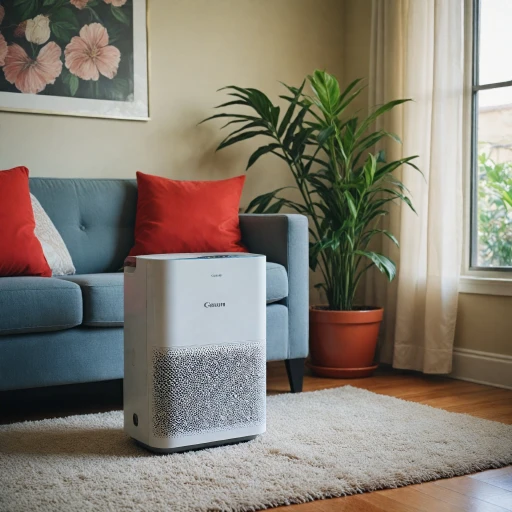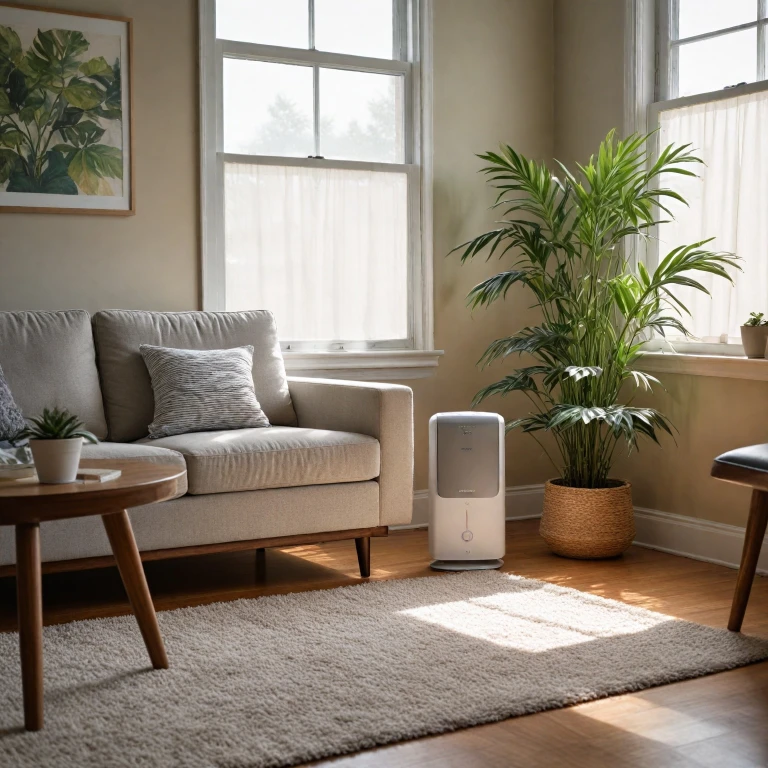Understanding how air purifiers work
The Mechanism Behind Air Purifiers
When considering whether air purifiers can effectively reduce dust in your home, it's essential to grasp how these devices operate. Air purifiers function by circulating air through various types of filters, capturing different types of particles, including dust. This process not only assists in creating cleaner air but also contributes to overall improved air quality.
Air purifiers often utilize high-efficiency particulate air (HEPA) filters, which set the standard for capturing dust particles. HEPA filters are designed to trap at least 99.97% of particles as small as 0.3 microns, ensuring that even tiny dust mites and pet dander are removed from your indoor air. This capability helps to reduce allergens and maintain a cleaner environment.
Air purifiers are not just single-function devices; they offer a multi-layer approach. Some models employ pre-filters to capture larger particles, such as visible dust and hair, before the air passes through finer filters. Others incorporate activated carbon filters to control odors and volatile organic compounds (VOCs), further enhancing indoor air quality by minimizing irritants that contribute to "dusty" air.
For optimal performance, it is vital to select an air purifier that matches your room's dimensions, ensuring effective air turnover and dust reduction. Regular maintenance, including cleaning or replacing filters as required, is crucial for sustaining the purifier's efficacy in trapping unwanted particles.
Reliability of an air purifier in reducing dust relies on its design, filter technology, and maintenance, making these an instrumental ally for a dust-free home. To explore deeper insights into achieving a dust-free environment, the benefits of (active air purifiers) are indispensable considerations. In subsequent sections, we'll delve further into the various types of purifiers and their effectiveness in dust abatement.
Types of air purifiers and their effectiveness
Various Air Purifier Technologies and Their Roles
Air purifiers employ different technologies to target and capture dust particles, each offering varying levels of efficiency in improving air quality. Let's delve into some of the most common types and their mechanisms.
HEPA Filters: The Gold Standard for Clean Air
High-Efficiency Particulate Air (HEPA) filters are renowned for their ability to capture up to 99.97% of particles as small as 0.3 microns. These purifiers can effectively reduce indoor air pollutants, such as dust mites, pet dander, and other allergens. HEPA filters play a crucial role in achieving a dust-free environment, making them a popular choice for many households.
Enhancing a dust-free environment with air purifiers.
Activated Carbon Filters: Targeting Odors and Gases
While not primarily designed for dust removal, activated carbon filters complement HEPA filters by adsorbing odors and volatile organic compounds (VOCs). These filters can help improve overall indoor air quality, but their focus isn't primarily on reducing dust levels.
Electrostatic Precipitators: Static for Particle Capture
Electrostatic precipitators use electric charges to capture particles air carries. While efficient in reducing dust air, their maintenance can be demanding since they require frequent cleaning to maintain high performance.
Ionizers: Negative Ions for Better Dust Control
Ionizers release negative ions into the air, leading to the aggregation of dust particles, which then settle on surfaces. This method can reduce airborne dust but may require additional cleaning to maintain optimal results in the room.
When selecting an air purifier, understanding the technologies involved can significantly impact its performance in reducing dust levels. Transitioning from general purifiers to those tailored for your specific needs will help achieve a cleaner indoor environment. The choice ultimately depends on your priorities, such as removing dust or targeting other indoor air quality concerns.
Factors influencing dust reduction
Key Factors That Affect Dust Mitigation
When evaluating air purifiers' potential to reduce dust in your home, it's essential to consider various factors that can influence their performance. These factors can significantly impact the purifier's ability to deliver cleaner indoor air, potentially reducing dust levels effectively.
- Type and quality of the filter: Not all air purifiers come with the same type of filter. High-efficiency particulate air (HEPA) filters are renowned for their capability to capture micro particles, including dust mites and pet dander. They are acclaimed for their high performance in reducing dust and improving air quality, making them a preferred choice for many seeking clean air in their homes.
- Airflow and room size: The efficacy of air purifiers in dust reduction largely depends on the volume of air they can process. An air purifier with a powerful airflow ensures that more air passes through the filters, thus capturing a greater amount of dust particles. Optimizing room size with the appropriate air purifier can significantly influence its cleaning ability. For more details on how airflow plays a crucial role in air purifiers, check out this insightful analysis on the role of airflow and air filters.
- Location of the purifier: Strategic placement of the air purifier can make a notable difference in its dust capturing efficiency. Placing the purifier in areas where dust accumulation is higher or near known sources of dust, such as windows or the living room, can enhance its dust removal effectiveness.
- Maintenance and cleaning of filters: Regular maintenance, including cleaning and replacing filters, is essential to ensure the purifier operates at its best. A clogged filter can significantly reduce the purifiers' ability to trap dust efficiently, leading to poorer air quality and increased dust levels.
Understanding these factors provides a clearer perspective on choosing an air purifier that not only aligns with your home's specific needs but also optimizes its dust reduction capacity. By considering the impact of these variables, you can more effectively utilize air purifiers in your ongoing efforts to maintain a cleaner, healthier indoor environment.
Comparing air purifiers to other dust reduction methods
Comparing Air Purifiers with Traditional Methods
When it comes to reducing dust in your home, it's essential to weigh the effectiveness of air purifiers against more traditional cleaning methods. While air purifiers offer a technological edge, manual methods and systems can play a significant role in maintaining a dust-free environment.
- Vacuuming and Dusting: Frequent vacuuming and dusting directly target dust particles on surfaces. High-efficiency vacuum cleaners with HEPA filters can capture fine dust particles, making them nearly as effective as some air purifiers in improving indoor air quality. Regular use of dusting cloths is crucial for removing settled dust on furniture and floors.
- HVAC Systems: Utilizing your home's HVAC system with high-quality filters can significantly improve indoor air quality. An efficient HVAC system can capture dust particles circulating through the air with its air filters. While they can manage general air quality, HVAC systems might not focus solely on dust reduction like a dedicated air purifier.
- Outdoor Air Exchange: Occasionally airing out your home can lower indoor dust levels by allowing fresh outdoor air to replace contaminated indoor air. This method, however, is not as controlled or efficient as using an air purifier, especially in areas with outdoor pollution.
- Lifestyle and Cleaning Routines: Consistent cleaning habits and reducing sources of dust—such as minimizing clutter or using air-tight storage—can make a significant difference. For instance, reducing pet dander through regular grooming or choosing fabric couches over leather can help dust and other allergens from accumulating.
In comparing these methods, air purifiers have specific advantages, such as the ability to continuously filter air and capture a range of dust particles, allergens, and pet dander. However, they perform best as part of a comprehensive dust-reduction strategy that includes traditional methods for a consistently clean environment. Balancing modern technology with tried-and-true cleaning strategies is key to achieving the best results.
Choosing the right air purifier for dust reduction
Picking the Perfect Solution for Your Home
Selecting the appropriate air purifier for dust reduction requires a keen understanding of your specific needs and environment. Here's a guide to help you make an informed decision:
- Consider Room Size: The size of the room plays a significant role in choosing an air purifier. Look for purifiers that specify the recommended room size or the Clean Air Delivery Rate (CADR), ensuring it can effectively clean the air within your space.
- Look for True HEPA Filters: Filters are crucial in capturing tiny dust particles, pet dander, and allergens. Opt for purifiers with True HEPA filters, as they are known for their high efficiency in trapping particles as small as 0.3 microns, thus improving indoor air quality.
- Examine Filter Replacement Costs: Regular maintenance and replacement of filters are essential for the optimal performance of your purifier. Consider the long-term cost and availability of replacement filters when making your choice.
- Energy Efficiency: Since air purifiers often run continuously, choose one with energy-efficient features to help save on electricity bills.
- Additional Features: Modern air purifiers come with features such as air quality indicators, programmable timers, and smart technology. These can enhance convenience and provide insights into indoor air conditions.
Balancing these factors with your budget and lifestyle can greatly impact the effectiveness of dust reduction in your home. Remember to regularly maintain and clean your chosen air purifier to ensure it continues to perform at its best, keeping the air in your living space fresh and clean.
Real-life experiences and testimonials
Personal Accounts on Air Purifier Efficacy
When it comes to assessing the performance of air purifiers in reducing dust in your home, real-life experiences can provide invaluable insights. Across numerous households, individuals have reported noticeable reductions in dust levels after integrating an air purifier into their indoor spaces. Here are some common observations and experiences highlighted by users:
- Improved Air Quality: Many users have noticed that air purifiers equipped with HEPA filters significantly improve indoor air quality by effectively capturing dust particles, allergens, and even pet dander. This improvement is often felt within just a few days of use.
- Enhanced Cleanliness: By using an air purifier, homes feel cleaner. Dust on furniture and surfaces reduces noticeably, helping to extend the time between regular cleaning sessions.
- Reduction in Allergic Reactions: Individuals sensitive to dust mites or pet allergens often report fewer allergic reactions and respiratory issues, attributing these improvements to the air purifier’s ability to remove particulates from the air.
- Convenience with Placement: Users emphasize that correctly placing the air purifier within a room—ideally a central location—can enhance the unit’s efficiency in reducing dust particles throughout the entire space.
- Quiet Operation: Some air purifier models are praised for their quiet operation, enabling them to run continuously without disrupting daily activities or sleep, which is crucial for long-term dust reduction and maintaining air quality.
It’s important to note that while many experiences are positive, the actual effectiveness of an air purifier can vary depending on several factors, including room size and air purifier specifications. For nuanced insights on choosing the right air purifier and understanding its capabilities, referring to detailed buying guides and performance reviews can be beneficial. Remember, maintaining high indoor air quality often requires a combination of an effective air purifier and other dust-reducing practices in your home.

